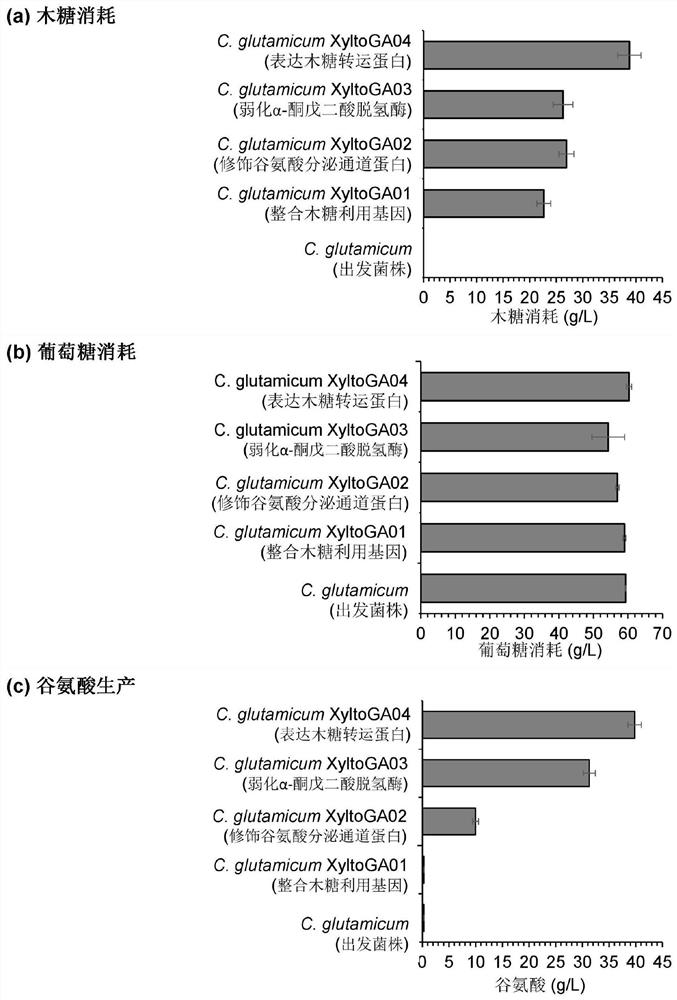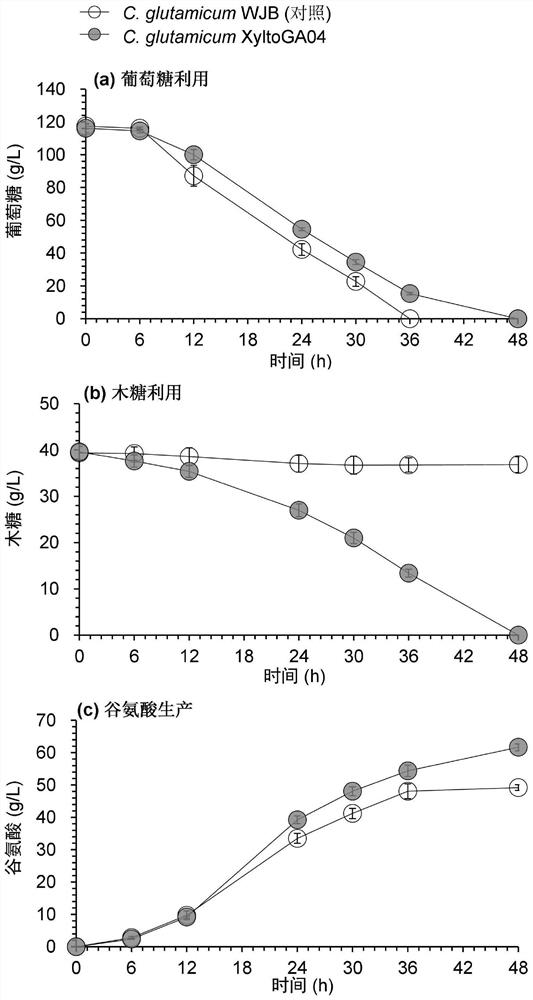Construction method of synthetic path for generating glutamic acid by utilizing xylose in corynebacterium glutamicum
A technology of glutamic acid rods, construction methods, applied in the field of genetic engineering
- Summary
- Abstract
- Description
- Claims
- Application Information
AI Technical Summary
Problems solved by technology
Method used
Image
Examples
Embodiment example 1
[0047] Example 1: The xylAB expression cassette was integrated into the ldhA gene locus of C. glutamicum
[0048] First construct the integrated plasmid of xylAB, and the specific construction method is as follows: use the genome of C. glutamicum as a template, use Peftu-F (as shown in the Peftu-F sequence in the sequence listing) and Peftu-R (as shown in the Peftu-F in the sequence listing) Shown in the R sequence) primers are amplified by PCR to obtain the Peftu promoter (as shown in the Peftu sequence in the sequence listing); with the genome of E.coliBL21 as a template, use xylAB_BL21-F (such as xylAB_BL21-F in the sequence listing sequence) and xylAB_BL21-R (as shown in the xylAB_BL21-R sequence in the sequence listing) primers are amplified by PCR to obtain xylAB_BL21 (as shown in the xylAB_BL21 sequence in the sequence listing) fragment; with Peftu and xylAB_BL21 as templates, Utilize Peftu-F and xylAB_BL21-R primer, obtain Peftu_xylAB_BL21 fusion fragment by the mode o...
Embodiment example 2
[0056] Example 2: Modification of glutamate secretion channel protein
[0057] First construct a knockout plasmid with 330 bases at the carbon end of MscCG, the specific construction method is as follows: use the genome of C. glutamicum as a template, use MscCG-up-F (as shown in the MscCG-up-F sequence in the sequence listing) and MscCG-up-R (as shown in the MscCG-up-R sequence in the sequence listing) primers amplify the MscCG-up fragment (as shown in the MscCG-up sequence in the sequence listing) by PCR (operation with Example 1) with the genome of C.glutamicum as a template, using MscCG-down-F (as shown in the MscCG-down-F sequence in the sequence listing) and MscCG-down-R (as shown in the MscCG-down-R in the sequence listing sequence shown) primers are amplified by the method of PCR (operation with Example 1) to obtain the MscCG-down fragment (as shown in the MscCG-down sequence in the sequence listing); with MscCG-up and MscCG-down as templates, using -up-F and MscCG-dow...
Embodiment example 3
[0058] Example 3: Weakening the expression of α-ketoglutarate dehydrogenase
[0059] The original RBS sequence replacing odhA is firstly constructed to be an integrated plasmid with an RBS sequence whose transcription initiation strength is 0.1. The specific construction method is as follows: using the genome of C. glutamicum as a template, using odhA-up-F (such as odhA-up-F in the sequence listing shown in the up-F sequence) and odhA-up-R (as shown in the odhA-up-R sequence in the sequence listing) primers are amplified by the method of PCR (operation with Example 1) to obtain the odhA-up fragment (as shown in the sequence odhA-up sequence shown in the list); with the genome of C.glutamicum as a template, using odhA-down-F (as shown in the odhA-down-F sequence in the sequence listing) and odhA-down-R (as shown in the sequence Shown in the odhA-down-R sequence in the list) primers are amplified by the method for PCR (operation with embodiment 1) to obtain the odhA-down fragmen...
PUM
 Login to View More
Login to View More Abstract
Description
Claims
Application Information
 Login to View More
Login to View More - R&D
- Intellectual Property
- Life Sciences
- Materials
- Tech Scout
- Unparalleled Data Quality
- Higher Quality Content
- 60% Fewer Hallucinations
Browse by: Latest US Patents, China's latest patents, Technical Efficacy Thesaurus, Application Domain, Technology Topic, Popular Technical Reports.
© 2025 PatSnap. All rights reserved.Legal|Privacy policy|Modern Slavery Act Transparency Statement|Sitemap|About US| Contact US: help@patsnap.com



